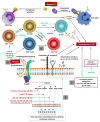MicroRNA (miRNA): A New Dimension in the Pathogenesis of Antiphospholipid Syndrome (APS)
- PMID: 32197340
- PMCID: PMC7139820
- DOI: 10.3390/ijms21062076
MicroRNA (miRNA): A New Dimension in the Pathogenesis of Antiphospholipid Syndrome (APS)
Abstract
MicroRNAs (miRNAs) are single-stranded, endogenous RNA molecules that play a significant role in the regulation of gene expression as well as cell development, differentiation, and function. Recent data suggest that these small molecules are responsible for the regulation of immune responses. Therefore, they may act as potent modulators of the immune system and play an important role in the development of several autoimmune diseases. Antiphospholipid syndrome (APS) is an autoimmune systemic disease characterized by venous and/or arterial thromboses and/or recurrent fetal losses in the presence of antiphospholipid antibodies (aPLs). Several lines of evidence suggest that like other autoimmune disorders, miRNAs are deeply involved in the pathogenesis of APS, interacting with the function of innate and adaptive immune responses. In this review, we characterize miRNAs in the light of having a functional role in the immune system and autoimmune responses focusing on APS. In addition, we also discuss miRNAs as potential biomarkers and target molecules in treating APS.
Keywords: APS; MicroRNA; antiphospholipid syndrome; autoimmunity; miRNA.
Conflict of interest statement
The authors declare no conflict of interest.
Figures

Similar articles
-
New Biomarkers for Atherothrombosis in Antiphospholipid Syndrome: Genomics and Epigenetics Approaches.Front Immunol. 2019 Apr 16;10:764. doi: 10.3389/fimmu.2019.00764. eCollection 2019. Front Immunol. 2019. PMID: 31040845 Free PMC article. Review.
-
Circulating microRNAs as biomarkers of disease and typification of the atherothrombotic status in antiphospholipid syndrome.Haematologica. 2018 May;103(5):908-918. doi: 10.3324/haematol.2017.184416. Epub 2018 Mar 15. Haematologica. 2018. PMID: 29545345 Free PMC article.
-
The Extensive Regulation of MicroRNA in Immune Thrombocytopenia.Clin Appl Thromb Hemost. 2022 Jan-Dec;28:10760296221093595. doi: 10.1177/10760296221093595. Clin Appl Thromb Hemost. 2022. PMID: 35536600 Free PMC article. Review.
-
Delineating the deranged immune system in the antiphospholipid syndrome.Autoimmun Rev. 2016 Jan;15(1):50-60. doi: 10.1016/j.autrev.2015.08.011. Epub 2015 Aug 28. Autoimmun Rev. 2016. PMID: 26318678 Review.
-
Intravenous immunoglobulins and antiphospholipid syndrome: How, when and why? A review of the literature.Autoimmun Rev. 2016 Mar;15(3):226-35. doi: 10.1016/j.autrev.2015.11.009. Epub 2015 Dec 1. Autoimmun Rev. 2016. PMID: 26656906 Review.
Cited by
-
Antiphospholipid Antibodies as Key Players in Systemic Lupus Erythematosus: The Relationship with Cytokines and Immune Dysregulation.Int J Mol Sci. 2024 Oct 20;25(20):11281. doi: 10.3390/ijms252011281. Int J Mol Sci. 2024. PMID: 39457063 Free PMC article. Review.
-
Small-Extracellular-Vesicle-Derived miRNA Profile Identifies miR-483-3p and miR-326 as Regulators in the Pathogenesis of Antiphospholipid Syndrome (APS).Int J Mol Sci. 2023 Jul 18;24(14):11607. doi: 10.3390/ijms241411607. Int J Mol Sci. 2023. PMID: 37511365 Free PMC article.
-
Recent Advances in Anticoagulant Treatment of Immune Thrombosis: A Focus on Direct Oral Anticoagulants in Heparin-Induced Thrombocytopenia and Anti-Phospholipid Syndrome.Int J Mol Sci. 2021 Dec 22;23(1):93. doi: 10.3390/ijms23010093. Int J Mol Sci. 2021. PMID: 35008518 Free PMC article. Review.
-
Antiphospholipid Syndrome in Pregnancy: New and Old Pathogenetic Mechanisms.Int J Mol Sci. 2023 Feb 6;24(4):3195. doi: 10.3390/ijms24043195. Int J Mol Sci. 2023. PMID: 36834614 Free PMC article. Review.
-
Enzyme-Assisted Nucleic Acid Amplification in Molecular Diagnosis: A Review.Biosensors (Basel). 2023 Jan 19;13(2):160. doi: 10.3390/bios13020160. Biosensors (Basel). 2023. PMID: 36831926 Free PMC article. Review.
References
Publication types
MeSH terms
Substances
Grants and funding
LinkOut - more resources
Full Text Sources
Miscellaneous

